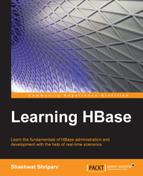In a driver class provided by Hadoop, we can run HBase JAR files utilizing the features of Hadoop and using the following command:
hadoop jar <HBase Jar file path>/hbase-*.jar<program name>
The program names we can use here are:
completebulkload: This is for a bulk data loadcopytable: This is to export a table data from the local to peer clusterexport: This is to export data from an HBase table to HDFS as a sequence fileimport: This is to import data written byexportimporttsv: This is to import data in TSV format to HBaserowcounter: This is to count rows in an HBase table using MapReduceverifyrep: This is to compare the data from tables of different clusters
We will discuss the preceding methods in the next chapter, where we will also discuss the backup/restore process. Likewise, we can call the HBase JAR file with Hadoop. The following are the Hadoop tools:
- HFile tool: This tool helps us to read an HFile content in text format. We can use it as:
hbase org.apache.hadoop.hbase.io.hfile.hfileThis is a very useful tool, as
hfileis not in human-readable format, and if we need to see the content, this tool fits well. - FSHLog tool: This tool can be used to read WAL files in human-readable format. We can use it as:
hbase org.apache.hadoop.hbase.regionserver.wal.FSHLog --dump <hbaselocationlogfile>We can also use it to split log files, as follows:
hbase org.apache.hadoop.hbase.regionserver.wal.FSHLog --split <hbaselocationlogfile>We have
HLogPrettyPrinter, which prints the contents of the HBase log file and WALPlayer to replay WAL log files. - Counting rows or cell efficiently: An inbuilt HBase counter is much slower as it scans through the HBase tables and huge tables take a lot of time. So, if we need to count the number of records or number of cells for a table, we have an option, using which we can do it in less time. This runs the MapReduce task for the same.
Use the following command to count rows as a MapReduce task:
hbase org.apache.hadoop.hbase.mapreduce.RowCounter <tablename>The preceding command will show the number of rows in a specified HBase table. For more detailed statistics of records, we can use
CellCounterorRowCounter, which we will see next.A cell counter results in detailed counts; it provides the following once completed:
- The number of rows in the table
- The number of column families across all rows
- The number of qualifiers across all rows
- The number of occurrences of each column family
- The number of occurrences of each qualifier
- The number of versions of each qualifier
We can use
CellCounteras follows:hbase org.apache.hadoop.hbase.mapreduce.CellCounter <tablename><outputDir> [regex or prefix] - Offline compaction tool: This can be used to run compactions in the offline mode. It can be run as follows:
hbase org.apache.hadoop.hbase.regionserver.CompactionTool
